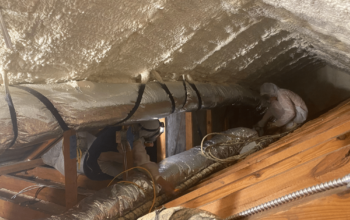Eco-friendly houses are energy-efficient and sustainable. Many rely on solar power for both space and water heating, and some rely on wind power. Most have some features that conserve water, and some have systems that have been designed to harvest rainwater.
If built from scratch rather than converted to make them eco-friendly, their design is more environmentally friendly than traditional houses, and the design is based on the concept of a thermal envelope that shields the indoor living spaces from the outdoor environment. Eco-friendly houses incorporate sustainable materials too, for construction as well as furniture, fittings, and soft furnishings.
Eco-friendly houses are very well insulated and designed so that the structure forms a thermal envelope, keeping the interior cool in summer and warm in winter. They also incorporate air and water vapor retarders to prevent mold and the chance of wood rotting, as well as sustainable heating, ventilation, and air-conditioning systems that prevent health risks. Solar water and space heating, anaerobic waste digesters, and greywater systems that enable the reuse of water from dishwashers and washing machines are also common.
Inside eco-friendly houses you will find energy-efficient appliances, usually Energy Star, and energy-efficient lighting too.
Technology has improved radically over the past few decades, making it cheaper and easier to make our homes eco-friendly.
How does an eco-house save you money
While people, in general, consider them to be a lot more expensive to build or convert to than conventional houses that are not eco-friendly, the savings are worth it. While they do cost more, a rule of thumb is that this will only reflect an increase of about 10%. An eco-friendly house might also take a little longer to build, particularly if the contractor doesn’t have a lot of experience with environmentally friendly materials, techniques, and products. But organizations like the U.S. Department of Energy’s Building America are working hard to ensure that the home building industry can produce quality homes that use as much as 50% less energy without costing any more to build.
Of course, the bigger and more elaborate any house is, the more it’s going to cost to build, which is why size is an important consideration where eco-friendly houses are concerned. Costs will also be increased by professionals, like engineers who play a pivotal role in designing heating, ventilation, and air-conditioning (HVAC) systems and even sophisticated plumbing systems. But in the long run, you will save the money spent by consulting with someone who specializes in plumbing or mechanical engineering services in Chicago, New York, or whichever city or region you live in.
Eco-Friendly Houses are Sustainable
Sustainable construction involves the use of environmentally-responsible and resource-efficient materials and processes to build and maintain buildings right the way through their life-cycle. Sustainability reduces negative environmental and health impacts because, amongst other things, non-toxic materials are used, waste is minimized, and the quality of air is maximized.
Environmental protection is a major benefit of sustainable construction. The other is potentially lower cost primarily from locally sourced materials and the fact that products used are more durable and will, therefore, last longer. Sustainability also minimizes waste of all kinds (including water and energy) and both air and water pollution, which cuts costs further. Cutting down on domestic waste also saves money, though this impacts positively on local authority budgets rather than the household because less rubbish ends up in landfill. Recycling adds to this figure.
Eco-Friendly Houses Cost Less to Operate
Alternative energy, like solar power, cuts fuel bills dramatically. These costs are cut further by limiting heat loss through the building from hot water heaters, hot water pipes, hot air ducts and so on.
Lighting systems that utilize compact fluorescent lamps (CFLs) and light-emitting diodes (LEDs) save money because they are energy efficient. But, in addition to this, the way the house and its windows are positioned to make clever use of natural daylight adds to this saving.
Graywater and rainwater harvesting systems cut water bills because less water is wasted. Using energy-efficient appliances also saves money because less energy and less water are used – depending, of course, on the appliance concerned.
Eco-Friendly Houses Qualify for Energy-Efficient Mortgages
Energy-Efficient Mortgage (EEM) Programs encourage people to build eco-friendly houses and refit older houses to make them environmentally friendly. Added to primary mortgages or home loans for upgrades, energy-efficient or “green” mortgages are offered by mortgage companies, banks, and credit unions.
In essence, if you are buying an eco-friendly house or building one, your monthly bills will be lower, which will qualify you for a larger mortgage.
In the U.S., it is possible to apply for this type of financing via conventional and government-insured loan programs. There are also state energy programs in some U.S. states. In the European Union, 37 major banks launched an energy-efficiency mortgage pilot scheme in 2018.
In the U.S., when you apply for an EEM, your house will be rated by a professional energy rater who is also certified by an accredited home energy rating system (HERS). This person will check insulation, window efficiency, air leakage, heating and cooling systems, and all other energy-related features. The rating report will include an estimate of annual energy usage and costs. It might recommend upgrades and calculate the potential annual savings as well as payback time.
To qualify for the maximum energy-efficiency financing, the report has to show the house really is energy-efficient. If it isn’t, but the recommended upgrades will be undertaken, it will take this into account.
Of course, it doesn’t have to be a hit-and-miss scenario, rather, you could consult a professional company, like a New York or Chicago engineering firm, or any specialist in your area, to advise what needs to be done for you to qualify for as much money as possible to reach your energy efficiency goals. And if you are building from scratch, use companies that specialize in eco-friendly houses, it will be worth it financially, environmentally, and from every other perspective.
(Photo courtesy: Michael Tobias, Shutterstock)
Related Posts












